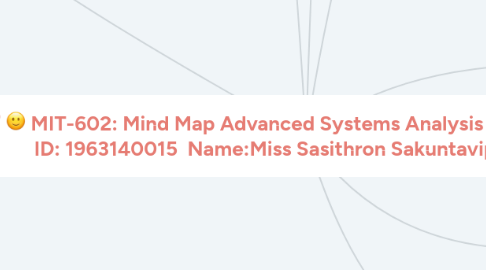
1. Object-oriented Analysis and Development (OOAD) using UML.
1.1. Data Flow Diagram
1.2. Use Case Diagram
1.3. Activity Diagram
1.4. Class Diagram
1.5. System Flow Diagram
1.6. Business flow Diagram
2. Data-dictionary
2.1. Active Data Dictionary
2.2. Passive Data Dictionary
2.3. Data attribute example
2.3.1. Field ID
2.3.2. Field Name
2.3.3. Data Type
2.3.4. Field Size for display
2.3.5. Data Description
2.3.6. Data Example
3. System Development Life Cycle (SDLC)
3.1. Understanding SDLC Conceptual
3.1.1. Planing Phase
3.1.1.1. Analysis Phase
3.1.1.2. Design Phase
3.1.1.3. Implementation Phase
3.1.2. System Development Phase
3.1.3. Problem Reorganization/Got it
3.1.4. System Analysis
3.1.5. System Design
3.1.6. System construction
3.2. Requirement Gathering
3.2.1. Business Understanding
3.2.2. User Stories
3.2.3. Acceptance Criteria
3.3. Problem Analysis
3.3.1. Problem Statement
3.3.2. Problem Scope
3.3.2.1. Functional Requirement
3.3.2.2. Non-Function Requirement
3.3.2.3. Project Scope
3.3.3. System Requirement
3.3.3.1. Service Request
3.4. System Design
3.4.1. Business Flow
3.4.2. Context Diagram
3.4.3. Use Case Diagram
3.4.4. User Interface Design
3.4.5. Input/Output Design
3.4.6. Prototype
3.4.7. PESUDO Code Design
3.5. System Development
3.5.1. Approaches
3.5.1.1. Ad-Hoc
3.5.1.2. Database
3.5.1.3. Top-Down
3.5.1.4. Bottom-Up
3.5.2. Architectures
3.5.2.1. File-Server
3.5.2.2. Client-Server
3.5.2.3. Centralized
3.5.3. Development Scope
3.5.3.1. Hardware
3.5.3.2. Software
3.5.3.3. Database
3.5.3.4. Network
3.5.3.5. People
3.5.3.6. Innovation concept and Tools
3.6. Testing
3.6.1. Testing Strategy
3.6.1.1. Black-Box Testing
3.6.1.2. White-Box Testing
3.6.2. Documentation
3.6.2.1. Test Plan
3.6.2.2. Test Case
3.6.2.3. Test Report
3.6.2.4. Test Log
3.6.2.5. Test Spec Audit Checklist
3.6.3. Testing Types
3.6.3.1. Unit Testing
3.6.3.2. Integration Testing
3.6.3.2.1. Dynamic Type
3.6.3.3. User Acceptance Testing
3.6.3.4. Penetration Testing
3.6.3.5. Inspection
3.6.3.6. Walkthrough
3.6.3.6.1. Static Type
3.6.3.7. Logical Checking
3.7. System Integration & Maintenance
3.7.1. Maintenance
3.7.1.1. System Rejuvenation
3.7.1.2. Maintenance Type
3.7.1.2.1. Adaptive Maintenance
3.7.1.2.2. Perspective Maintenance
3.7.1.2.3. Corrective Maintenance
3.7.1.2.4. Preventive Maintenance
3.7.1.3. System Comprehension
3.7.2. Integration
3.7.2.1. Documentation
3.7.2.1.1. Installation Guide
3.7.2.1.2. User manual
3.7.2.1.3. Guidance Procedure
3.7.2.2. Implementation Plan
3.7.2.2.1. Phased Conversation
3.7.2.2.2. Modular Prototype
3.7.2.2.3. Distributed Conversation
3.7.2.2.4. Direct Changeover
3.7.2.2.5. Parallel Conversation
4. Design Thinking (Smile Focus)
4.1. User Interface Design Conceptual (UI)
4.2. User Experience Conceptual (UX)
4.3. Software Feature idea & Brainstorm
5. Software Engineering and Water Fall Model Conceptual Learning.
5.1. Model of Software Engineering.
5.1.1. Water Fall Model
5.1.2. Built-and-Fix Model
5.1.3. Incremental Model
5.1.4. Spiral Model
5.1.5. Joint Application Development (JAD) Model
5.1.6. Rapid Application Development (RAD) Model
5.1.7. Unified Process (UP)
5.1.8. Agile Methodology.
5.1.9. SCRUM Methodology.
5.2. Software Engineering Foundation Concept.
5.2.1. Software Engineering Requirement.
5.2.2. Software Development.
5.2.3. Software Validation.
5.2.4. Software Tester
5.2.4.1. PSEUDO Code Test
5.2.5. Software Evolution
6. Documentation
6.1. System Requirement Document
7. Project Management
7.1. Project Scope
7.2. Project Planning
7.3. Project Timeline Management
7.3.1. Deliverable Milestone
7.3.2. Success Task Milestone
7.4. Project Cost Management
7.4.1. Budgeting Control&Management
7.5. Project Quality Management
7.5.1. Quality Audit as Requirement Specification
